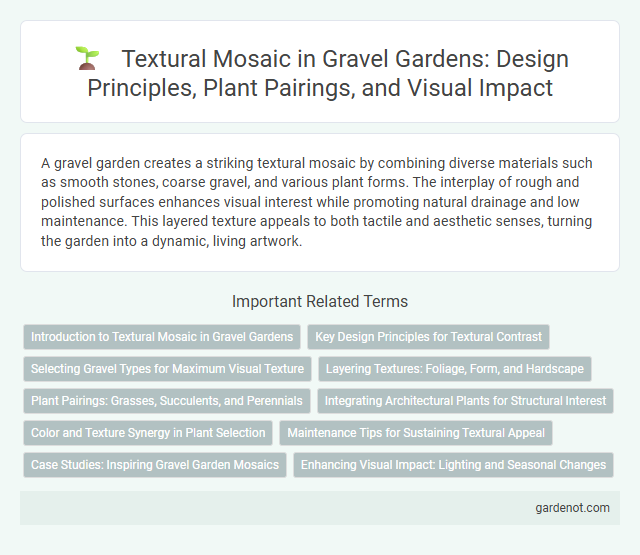A gravel garden creates a striking textural mosaic by combining diverse materials such as smooth stones, coarse gravel, and various plant forms. The interplay of rough and polished surfaces enhances visual interest while promoting natural drainage and low maintenance. This layered texture appeals to both tactile and aesthetic senses, turning the garden into a dynamic, living artwork.
Introduction to Textural Mosaic in Gravel Gardens
Textural mosaic in gravel gardens combines varied plant forms and foliage to create visual interest and dynamic contrast. Incorporating coarse, fine, and medium textures enhances the garden's depth and sensory appeal, preventing monotony in the gravel landscape. Strategic plant selection emphasizes texture interplay, boosting biodiversity and garden resilience.
Key Design Principles for Textural Contrast
Textural contrast in gravel garden design relies on combining diverse materials such as smooth pebbles, coarse gravel, and rough bark mulch to create visual interest. Incorporating plants with varied leaf shapes and sizes, like spiky ornamental grasses alongside soft, rounded succulents, enhances the tactile experience. Strategic layering and spacing maintain balance while highlighting the distinct textures, ensuring an engaging and dynamic outdoor space.
Selecting Gravel Types for Maximum Visual Texture
Choosing varied gravel types such as pea gravel, crushed stone, and decomposed granite enhances the textural mosaic by creating contrasting shapes, sizes, and colors. Combining angular and rounded gravel particles increases depth and interest by reflecting light differently throughout the garden. Strategic blending of gravel textures emphasizes garden pathways and planting beds, maximizing visual appeal and sensory experience.
Layering Textures: Foliage, Form, and Hardscape
Layering textures in a gravel garden creates a dynamic textural mosaic by combining varied foliage shapes, contrasting forms, and complementary hardscape elements. Using plants with diverse leaf sizes and colors alongside structured gravel patterns emphasizes depth and visual interest. Incorporating sculptural stones, weathered rocks, and smooth pebbles enhances the interplay between natural and architectural textures for a balanced garden composition.
Plant Pairings: Grasses, Succulents, and Perennials
Textural mosaics in gravel gardens thrive by pairing ornamental grasses like Festuca glauca with succulents such as Sedum and perennial plants including Lavender and Echinacea, creating visual contrast and depth. The fine blades of grasses contrast with the fleshy leaves of succulents, while perennials add seasonal blooms and structural height, enhancing the garden's layered texture. Combining drought-tolerant species optimizes water efficiency and maintenance, making it ideal for sustainable gravel garden design.
Integrating Architectural Plants for Structural Interest
Textural mosaic in gravel gardens benefits greatly from integrating architectural plants such as agave, yucca, and ornamental grasses, which add height and sculptural form. These plants create strong visual focal points and break the monotony of gravel surfaces by introducing varied leaf shapes and patterns. Their drought tolerance and low maintenance ensure a sustainable yet striking structural interest throughout the seasons.
Color and Texture Synergy in Plant Selection
Selecting plants with diverse leaf textures and complementary colors creates a vibrant textural mosaic essential for gravel garden design. Incorporating silver-gray foliage alongside deep green and burgundy hues enhances visual depth while maintaining harmony with the coarse, rocky substrate. Emphasizing texture and color synergy ensures year-round interest and a dynamic interplay between plant forms and the gravel matrix.
Maintenance Tips for Sustaining Textural Appeal
Maintaining a gravel garden's textural mosaic requires regular weeding and raking to preserve surface uniformity and prevent soil compaction. Use seasonal pruning of surrounding plants to avoid overgrowth obscuring the gravel's intricate patterns and textures. Applying a top layer of fresh gravel annually enhances color contrast and texture depth, sustaining visual interest throughout the year.
Case Studies: Inspiring Gravel Garden Mosaics
Gravel garden mosaics showcase innovative uses of varied textures and colors to create visually compelling outdoor landscapes. Case studies highlight projects where contrasting gravel sizes and hues form intricate patterns, enhancing both aesthetic appeal and drainage efficiency. These examples demonstrate how textural mosaics can transform minimalist gardens into dynamic, sustainable environments.
Enhancing Visual Impact: Lighting and Seasonal Changes
Integrating diverse gravel sizes and plant textures creates a dynamic textural mosaic that enhances the visual depth of a gravel garden. Strategic lighting highlights contrasting textures and shadows, amplifying the garden's appeal during evening hours. Seasonal changes in plant foliage and flower colors introduce evolving patterns that maintain year-round interest and emphasize the garden's layered textures.
Textural mosaic Infographic

 gardenot.com
gardenot.com